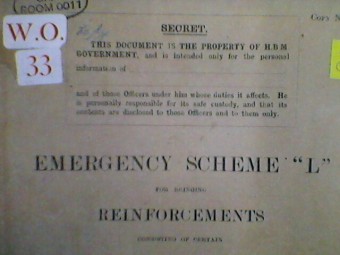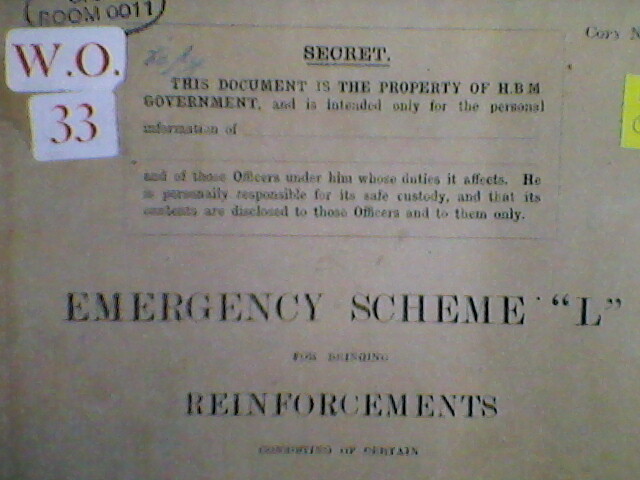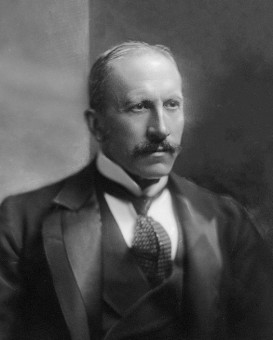‘I fear the time is very near at hand, when we will have to take some strong steps to stop the “rot” in this country, unless we wish to “follow Russia” into impotence & dissolution’, wrote Lord Alfred Milner in a letter to the Prime Minister dated 1 June 1917. [1]
Formerly Britain’s High Commissioner for South Africa – where he had schemed to provoke the Boer War [2] – Milner was now a member of Lloyd George’s five-man War Cabinet. With his letter he enclosed a memorandum from one Victor Fisher, a former member of the Marxist British Socialist Party (BSP), now the Secretary of the ‘patriotic labour’ group the British Worker’s League (BWL). [3]
Ostensibly a working-class organisation, behind the scenes Milner had been ‘largely responsible for organising’ the League, putting Fisher in contact with prominent figures in the Lloyd George government such as Waldorf Astor and Christopher Addison, and arranging funding for the group from the likes of the British Empire Producers Organisation, the shipping magnate Sir James Knott, and the British Sugar Growers Association. [4]
Milner saw the BWL as a means of ‘directly counter-acting the deliberate agitation of mischief makers’ – by force if necessary – and made sure that it inherited not just the assets of the pre-war right-wing National Service League, but also some of its professional political organizers, men ‘skilled in the arts of rabble-rousing and not afraid of violence’. [5]
Patriot mobs
By 1917 violent patriotic mobs had long been ‘one of the central mechanisms by which dissent was contained in wartime Britain’. [6] For example, an anti-conscription meeting in Kingston in November 1915, organised by the Union for Democratic Control (UDC), ‘was broken up before a word could be said’ and the organisers – including MP Arthur Ponsonby – physically assaulted. [7]
Nor were such attacks confined to London: by the end of 1915 Glasgow, which had one of the strongest anti-war and labour movements [8], ‘was about the only place in the UK in which this type of violence was not becoming endemic.’ [9]
This violence was ‘not simply the result of spontaneous popular anger’. [10] Indeed, ‘from at least the middle of 1915, [London] witnessed systematic right-wing efforts to organize patriotic counter-demonstrations that would prevent known anti-war leaders from holding political meetings of any kind. Journalists linked to Beaverbrook’s Daily Express [11], the London Globe, and the Anti-German Union appear to have played a leading role in this campaign, relying heavily on colonial servicemen garrisoned in the capital for the ‘muscle’ needed to break up anti-war meetings.’ [12]
The Battle of Cory Hall
Nor were such efforts were not confined to London. Indeed, the BWL – whose newspaper, the British Citizen and Empire Worker, had a circulation of roughly 25–30,000 [13], and by September 1917 had over 150 branches across the country [14] – was one of the key groups providing organisational form to such mob violence.
For example, at the ‘Battle for Cory Hall’ in Cardiff in November 1916, BWL Vice-President Charles Butt Stanton MP and one of the BWL’s national organisers, Captain E. Tupper, helped lead a ‘patriot’ attack on a meeting of 900 dissenters. [15] That morning Tupper – the members of whose union, the National Union of Seamen, ‘were very prominent in increasingly violent patriot disturbances in the latter war years’ – had sent a message to the Home Secretary, George Cave, warning him that if the meeting were not banned the seamen of the port would ‘tak[e] the matter into their own hands.’ [16]
Following speeches by the Earl of Plymouth, Lord Merthyr and others, Stanton led a mob of miners, ex-soldiers and others to the Hall, which was already under siege by a crowd of 1,500, including Fisher. When Stanton’s men arrived, shouting ‘Get into Khaki’ and ‘No Peace. Down with the Traitors!’, the door of the Hall was broken, the delegates attacked and the meeting terminated. [17]
Creeping fascism
‘Given its reactionary – sometimes nearly hysterical – message, the violent nature of much of its membership, its acceptance of a corporatist social model, and its militaristic, chauvinistic programme, it is not difficult to see the [BWL] as a proto-fascist organization’, notes historian Brock Millman. [18]
However, the BWL was not the only sign of a creeping fascism in wartime Britain.
Following the December 1916 coup that brought him to power, Lloyd George wanted to set up his own party, based around a doctrine he called ‘Nationalist Socialism’ [19]. Press barons were brought into his adminstration to serve in publicity ministries [20], businessmen were brought in to take control of government agencies, and the repression of dissent was stepped up. [21]
With its ‘vertical, corporatist reorganisation of the social, economic and political nation, accomplished through explicit appeals to patriotism as an integrating force beyond class and particular interest’ the Lloyd George government was ‘as with so much in the latter years of the First World War … a foretaste of the interwar fascist response’. [22]
‘A rude awakening’
The extent to which the state was involved in organising and encouraging ‘patriot’ violence is disputed [23]; that senior political, business and other elites – including members of the police – were doing this is not. [24]
In July 1917, when 250 delegates, including Bertrand Russell and several servicemen, met in the Brotherhood in Islington, to promote the setting up of workers’ and soldiers’ councils, modelled on the those of the March 1917 Russian Revolution, they found themselves besieged by a mob of some 8,000 people, who had begun to gather long before the meeting’s start. [25]
Leaflets were calling on people to ‘remember the last air raid and roll up’, and the head of Special Branch, Basil Thomson arranged for the Daily Express to publish the place of the meeting in advance in order to guarantee the dissidents ‘a rude awakening’. [26]
The police were there in force, but did nothing to intervene as the Church’s door was smashed in using a sledge hammer, the delegates attacked, and the main hall ‘systematically smashed up’ [27]. One man, blood running down his face took refuge in a furniture van, but the police grabbed him and threw him back to the mob. Another nearly had his eye gouged out.
The police made one arrest, a delegate, claiming that any attempt to arrest the rioters would have ‘given them the opportunity of attacking the Church’!
Russell returned to speak at the Church in October, when ‘in spite’ of the presence of some 240 police officers, including 40 mounted officers, the mob was once again able to break into the Church again, this time setting fire to it. [28]
The National War Aims Committee
On 5 June 1917, four days after Milner’s letter to Lloyd George, quoted above, the War Cabinet decided ‘to undertake an active campaign to counteract the pacifist movement; which, it claimed ‘had the field to itself’. [29]
Their decision took place in the wake of significant industrial unrest, spanning 30 April – 12 May, in which some 200,000 men had gone on strike in over twenty towns, including Manchester, Sheffield, Rotherham, Coventry and London. [30] ‘The blow … to the government’s self-confidence’ caused by these strikes, notes historian David French ‘cannot be underestimated’. [31]
Within months a massive propaganda campaign – the National War Aims Committee (NWAC) – was flooding the country with pro-war propaganda, attempting to convince a war-weary nation of the need for ‘do[ing] all in its power to assist in carrying on the war to a victorious conclusion’. [32]
Officially an NGO, in reality is was ‘almost totally funded by the Treasury’, ‘receiv[ing] something like £1.2 million’ – over £50 million in today’s money – ‘in subsidy or services from government sources’ in the 18 months of its existence. [33]
Nonetheless, governmental fears persisted. A secret report from the Ministry of Labour, dated 9 August 1917 ‘referred to the growing influence of advocated of a negotiated peace’, and November saw the Home Secretary arranging for the NWAC, who would soon be receiving copies of CID intelligence reports, to get prior notice of all dissenting meetings so that it might ‘try and arrange out-door or in-door meetings as a counter-blast’. [34]
Emergency Scheme L
 Rightly or wrongly, by 1918 ‘many British leaders had come to view revolution as a distinct possibility by 1918’, and a strong, albeit circumstantial, argument can be made that 175,000 fully trained surplus troops were kept in Britain during 1918 to deal with just such a contingency. [35]
Rightly or wrongly, by 1918 ‘many British leaders had come to view revolution as a distinct possibility by 1918’, and a strong, albeit circumstantial, argument can be made that 175,000 fully trained surplus troops were kept in Britain during 1918 to deal with just such a contingency. [35]
‘[L]ists of those to be pre-emptively arrested in certain eventualities’ [36] were drawn up, as was a secret contingency plan – Emergency Scheme L – to deploy 19 infantry brigades – with a host of support and service formations, units and subunits – into three concentration areas ‘located near … regions of chronic unrest’. [37] Civil legal procedures would be suspended, and ‘preemptive military detention of suspected troublemakers’ – apparently ‘consist[ing] entirely of the leadership of the anti-war movement and known industrial agitators’ – would take place. [38]
Had the war continued much longer [39] who knows what ‘strong steps’ might have been considered necessary to ‘stop the “rot”’ and prevent Britain from ‘follow[ing] Russia’. It may be, as Brock Millman speculates, ‘that Britain got off the steam-train of history only one or two stops short of civil war’. [40]
NOTES
[1] Marvin Swartz, The Union of Democratic Control in British Politics During the First World War, Oxford University Press, 1971, p. 175.
[2] Adam Hochschild, To End All Wars, MacMillan, 2011, pp. 22 – 23. In 1917, following the ‘October Revolution’ in Russia, Milner ‘quietly but doggedly’ promoted the idea within the British Government that Britain should settle its differences with Germany ‘and then partition Russia among themselves’ (ibid., 293 – 294). He was also ‘a key architect of the Allied campaign to support right-wing anti-Bolshevik forces in Russia with arms, training, supplies, and eventually troops’ (ibid., p. 335)
[3] Formerly the British Worker’s National League (BWNL). The League changed its name in March 1917 (Alan Sykes, The Radical Right in Britain, Palgrave, 2005, p.37). To minimise confusion we refer to the League as the BWL throughout.
[4] Brock Millman, Managing Dissent in First World War Britain, Frank Cass, 2000, pp. 112, 114 – 115; Hochschild, op. cit., p.178. Following Lloyd George’s December 1916 coup, Waldorf Astor, 2nd Viscount Astor, a newspaper proprietor and Unionist MP, had become Lloyd George’s Parliamentary Private Secretary. Christopher Addison had become Minister of Munitions. Astor also backed the BWL to the tune of (at least) £2,980 (P.A. Lockwood, ‘Milner’s Entry into the War Cabinet, December 1916’, The Historical Journal, VII, I, (1964), p.123).
[5] Millman, op. cit., pp.114 – 115.
[6] Ibid., p.99. ‘[P]atriot violence quickly became became … a rather effective form of censorship useful in stopping dissenters from spreading their message by the spoken word, at least openly and to large audiences’. The Government meanwhile could claim that it was not suppressing dissent (by eg. censorship or banning meetings), while deliberately refraining from protecting the dissenters and allowing it to be suppressed: ‘a mechanism tailor-made for British scruples’ (ibid., pp. 57, 87)
[7] Ibid., p. 55
[8] Ibid., p.11. Paradoxically there were also ‘a disproportionately high number of volunteers from Scotland’ (Adrian Gregory, The Last Great War: British Society and the First World War, Cambridge University Press, 2008, p. 81).
[9] Millman, op. cit., p. 56.
[10] Jon Lawrence, ‘Public space, political space’, p. 294 in Jay Winter & Jean-Louis Robert, Capital Cities at War: Paris, London, Berlin, 1914 – 1919 vol.2, Yale University Press, 1992.
[11] Lord Northcliff’s papers, including the Daily Mail and the Evening News, appear to have played a significant role as well: ‘During the war, the Beaverbrook-Northcliff press can be considered to have had a virtually unified editorial line … If Beaverbrook tended to establish the direction, Northcliffe followed close behind and was perhaps more important, owing to his larger holdings (nearly two-thirds of London dailies, by circulation, were under his control), influence and connections … Violent suppression of dissent followed inevitably and naturally without HMG having to do much of anything more vigorous than avert its eyes and answer a few questions in the House.’ (Millman, op. cit., pp. 54-55).
[12] Lawrence, op. cit. Significantly, alongside Milner, Beaverbrook was a ‘silent partner’ in the coup that brought Lloyd George to power in December 1916, under whose premiership he would later become Minister of Information (Millman, op. cit., p. 126 – 127, 240). ‘[T]he change in government occurred when Carson, Lloyd George and Northcliffe combined to force Asquith from power. Silent partners in the combinaton were Lord Milner – linked to the conspirators by his disciple Geoffrey Dawson, editor of the Times, and an associate, therefore of both the press lords and Lloyd George – and the indispensable go-between Beaverbrook’ (ibid., pp. 126 – 127).
[13] Sykes, op. cit., p. 37.
[14] Ibid., p. 38.
[15] Millman, op. cit., pp.145, 153 – 154.
[16] Ibid., pp. 118, 153.
[17] Ibid., pp. 153 – 154. In a bizarre coda following the attack, the organizing secretary of the British Empire Union , Captain Atherley Jones – who had already played a key role in getting Bertrand Russell banned from a third of the country – wrote to Ramsey MacDonald (who had been one of the besieged speakers in the Hall) with a plea for money, ‘the counter-demonstration having cost over £100, and only £23 having been raised by conscription’! (ibid., p. 160).
[18] Ibid., p.118.
[19] Ibid., p. 129.
[20] Lord Northcliffe (owner of the Times, and Daily Mail) was made Britain’s Director of Propaganda; Lord Beaverbrook (owner of the rabidly pro-war Daily Express) was made Minister of Information; Lord Rothermere (co-founder of the Daily Mail) served as President of the Air Council (ibid., p. 191; ‘Harold Sidney Harmsworth, 1st Viscount Rothermere’, Encyclopedia Britannica, http://www.britannica.com/EBchecked/topic/510588/Harold-Sidney-Harmsworth-1st-Viscount-Rothermere; ‘Alfred Charles William Harmsworth, Viscount Northcliffe’, Encyclopedia Britannica, http://www.britannica.com/EBchecked/topic/419541/Alfred-Charles-William-Harmsworth-Viscount-Northcliffe).
[21] Millman, op. cit., pp. 174, 176-178.
[22] Millman, op. cit., p. 176.
[23] For example, Adrian Gregory argues that, while ‘[i]ndividuals in both the military and civil establishments certainly shared in the general paranoia and disontent of the middle and upper classes, and ‘patriot’ extremism was intermittently encouraged as an informal method of suppressing dissent’, Brock Millman is ‘probably wrong’ about the ‘the extent to which … the process [was] initiated and encouraged by state agencies’ (Adrian Gregory, The Last Great War: British Society and the First World War, Cambridge University Press, 2008, p. 208). To be sure, the State did not have full control over at least some of the forces that had been unleashed eg. by the summer of 1918 the Home Secretary ‘moved amidst a host of detectives and bodyguards while his house was surrounded by uniformed police’, because of fears of patriot violence directed at the government, stoked by the mainstream national press (Millman, op. cit., pp. 219 – 220). According to Gregory ‘Britain showed more signs of an embyonic Fascism than Germany’ at this time (Gregory, op. cit., p. 267).
[24] We have already seen the involvement of Lord Milner and Waldorf Astor in organising and funding the BWL, as well as the role of Beaverbrook’s Daily Express in mobilising mobs to attack dissenting meetings. All three held prominent political positions under Lloyd George (see note 20. above and ‘Waldorf Astor, 2nd Viscount Astor’, Encyclopedia Britanica, http://www.britannica.com/EBchecked/topic/39873/Waldorf-Astor-2nd-Viscount-Astor).
[25] Ken Weller, ‘Don’t be a Soldier!’ The Radical Anti-war Movement in North London 1914 – 1918, The Journeyman Press, 1985, pp. 87-88.
[26] Ibid., p. 88. According to Weller, the police had already intervened to deny the organisers their original choice of venue (ibid., p. 87). According to Bertrand Russell, ‘Patriotic newspapers distributed leaflets in the neighbouring public houses … saying that we were in communication with the Germans and signalled to their aeroplanes as to where to drop bombs.’ (Bertrand Russell, Autobiography, Unwin, 1987, p. 254).
[27] Weller, op. cit., p. 88. According to Weller, ‘windows and fanlights were broken and frames ripped out, the furniture was almost completely de stroyed, water pipes were pulled out of the walls and the hall was partially flooded’.
[28] Ibid., p. 90. The scare quotes are Weller’s.
[29] David Monger, Patriotism and Propaganda in First World War Britain: The National War Aims Committee and Civilian Morale, Liverpool University Press, 2014, p. 28.
[30] David French, The Strategy of the Lloyd George Coalition, 1916-1918, Oxford University Press, 1995, p. 86.
[31] Ibid., p. 69.
[32] Millman, op. cit., p. 237. NWAC propaganda included films, speeches, leaflets, and photographic exhibitions. By 1918 it was ‘reaching something like six million people weekly’ (ibid., p.240). In October 1917, Satire magazine aimed a satirical barb at the organisation, noting that ‘The War Aims Committee is going about the country to counteract the insidious propaganda of the pacifists. They are making a great success of it, for nobody knows yet what our war aims are’ (File 32, Bundle 3, HO 139/23, Public Record Office). Brought to the attention of the Director of Public Prosecutions, the latter struggled to find ‘any specific breach of the Regulations’, except one (‘Fables for Fools’) and so decided not to prosecute on these grounds. The problem was instead solved by prosecuting ‘the deaf and dumb Editor of the paper’, Leonard Augustine Motler, for having advertised an illegal lottery (ibid.). According to Nick Heath: ‘Motler’s place at 47 Crowndale Road in Camden was raided. All his manuscripts, cartoons, personal correspondence , typewriter, literature, paper stocks and complete set of back issues of Satire as well as funds to the value of £4.10 shillings were seized by the police’ (Nick Heath, ‘Motler, Leonard Augustine, 1888-1967’, http://libcom.org/history/motler-leonard-augustine-1888-1967).
[33] Millman, op. cit., pp. 233 – 234. Present day figure equivalent derived using http://www.measuringworth.com.
[34] Schwartz, op. cit., p. 176; Millman, op. cit., pp. 245 – 246. Home Secretary George Cave’s suggestion that ‘every pacifist gathering should be brought to the attention of the War Aims Committee or the British Worker’s League, in order that they may (if thought desireable) organize a loyal meeting to follow it’ (Monger, op. cit., p. 244) is cited by Brock Millman as evidence for his claim that ‘the most important purpose of the NWAC …. [was] to create the secret machinery by which dissenters could be intimidated and in the extreme physically suppressed … For the first time, patriot excess was not only tolerated, but organized, employed, even manufactured by the government’ (Millman, op. cit., p. 245). However, this interpretation has been strongly criticised by the author of the only scholarly work on the NWAC. Thus David Monger notes that while arrangements were made to keep the NWAC ‘abreast of developments, as Cave proposed … [this] was apparently not extended to the BWL’ (Monger, op. cit., p. 244). Moreover, Monger writes, ‘BWL involvement with the NWAC, while undeniable on occasion, was not a systematic partnership’ and Millman’s use of Cave’s suggestion to suggest the existence of a NWAC-BWL fusion that was the government’s ‘chosen instrument of suppression’ is ‘inexcusably misleading’ (ibid.). For this reason, we do not rely upon Millman’s more controversial assertions about the role of the NWAC.
[35] Millman, op. cit., Chapter 11 but especially pp. 287, 272; Adrian Gregory writes that Millman’s ‘arguments about troop deployments in Britain, designed to be utilised against urban revolt, are not very convincing’, though he also acknowledges that Millman’s claim that 1918 was ‘a year of “counter-revolution” in the making’ is ‘definitely close to the mark’ (Gregory, op. cit., p. 208).
[36] Ibid., p.4.
[37] Ibid., pp. 282, 289. Dated May 1918, Emergency Scheme L was nominally one of a host of contingency plans for ‘either a minor German landing aimed at London or at raiding elsewhere in the United Kingdom’, but there are good reasons to doubt that this was its real purpose (ibid., pp. 280 – 281, 289, 299 n.39).
[38] Ibid., p. 291.
[39] According to Millman ‘by winter 1917-18 the probable end to the war was typically being projected as taking place no earlier than the summer of 1919 (and more likely in 1920 or 1921)’, and even as late as early Autumn 1918 an Allied victory was considered ‘uncertain, and near victory unlikely’, with the war ending ‘suddenly and unexpectedly’ in November (ibid., pp. 224, 267, 304). In a similar vein David Stevenson writes that ‘in July and August 1918 hardly anyone in authority [on either side] expected the fighting to end quickly’ (David Stevenson, 1914 – 1918, Penguin, 2005, p. 466). Meanwhile, ‘[d]uring the spring and early summer of 1918, at the height of the German offensive, London witnessed a resurgence of crowd action against pacifist leaders as the organized ultra-right grew in strength and confidence’ (Lawrence, op. cit., p. 297). However, as soon as the crisis caused by Germany’s 1918 offensive had passed, ‘a wave of unrest swept across the factories’ (Churchill) to be followed by a rail strike and a police strike (Millman, op. cit., pp. 258, 262 – 263).
[40] Ibid., p. 268. One would have no inkling that any of these developments were taking place from watching Jeremy Paxman’s prime-time BBC television series, Britain’s Great War, focusing on the British home front. According to Paxman, ‘by and large for four years the British people kept faith with [the war]’ (‘At the Eleventh Hour’, BBC1, first broadcast 17 February 2014). Maybe so, but this was also a state of affairs that was deliberately created and maintained, through repression and propaganda, not simply a natural state of affairs.






